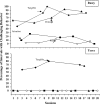A systematic examination of different parameters of presession exposure to tangible stimuli that maintain problem behavior
- PMID: 22102760
- PMCID: PMC3220272
- DOI: 10.1901/jaba.2009.42-773
A systematic examination of different parameters of presession exposure to tangible stimuli that maintain problem behavior
Abstract
We examined the effects of three different presession conditions on tangibly maintained problem behavior for 2 students with autism, using individual-participant multielement designs. First, an analogue functional analysis demonstrated that problem behavior was maintained by access to tangible items. Next, topographies of item rejection were identified. Finally, students were exposed to (a) brief access, (b) no access, and (c) satiation to the tangible items prior to tangible sessions. The results demonstrated high levels of problem behavior following the brief-access and no-access presession conditions and low levels of problem behavior following the satiation condition. The findings are discussed in the context of how satiation might best be defined for these sorts of evaluations.
Keywords: deprivation; functional analysis; motivating operations; problem behavior; satiation.
Figures



Similar articles
-
Examination of an antecedent communication intervention to reduce tangibly maintained challenging behavior: a controlled analog analysis.Res Dev Disabil. 2012 Sep-Oct;33(5):1462-8. doi: 10.1016/j.ridd.2012.03.017. Epub 2012 Apr 26. Res Dev Disabil. 2012. PMID: 22543058 Clinical Trial.
-
Analysis of Behavioral Indicators as a Measure of Satiation.Behav Modif. 2017 Mar;41(2):308-322. doi: 10.1177/0145445516673828. Epub 2016 Oct 22. Behav Modif. 2017. PMID: 27760808
-
An examination of within-session responding following access to reinforcing stimuli.Res Dev Disabil. 2016 Jan;48:25-34. doi: 10.1016/j.ridd.2015.10.013. Epub 2015 Oct 31. Res Dev Disabil. 2016. PMID: 26524727
-
Using social stories and comic strip conversations to promote socially valid outcomes for children with autism.Semin Speech Lang. 2006 Feb;27(1):47-59. doi: 10.1055/s-2006-932438. Semin Speech Lang. 2006. PMID: 16440244 Review.
-
Emerging themes in the functional analysis of problem behavior.J Appl Behav Anal. 1994 Summer;27(2):393-9. doi: 10.1901/jaba.1994.27-393. J Appl Behav Anal. 1994. PMID: 7520430 Free PMC article. Review.
Cited by
-
REDUCING AMBIGUITY IN THE FUNCTIONAL ASSESSMENT OF PROBLEM BEHAVIOR.Behav Interv. 2015 Feb;30(1):1-35. doi: 10.1002/bin.1400. Behav Interv. 2015. PMID: 26236145 Free PMC article.
-
The influence of motivating operations on generalization probes of specific mands by children with autism.J Appl Behav Anal. 2012 Fall;45(3):565-77. doi: 10.1901/jaba.2012.45-565. J Appl Behav Anal. 2012. PMID: 23060669 Free PMC article.
-
Effects of a motivating operation manipulation on the maintenance of mands.J Appl Behav Anal. 2012 Summer;45(2):443-7. doi: 10.1901/jaba.2012.45-443. J Appl Behav Anal. 2012. PMID: 22844154 Free PMC article.
-
Effects of motivating operations on problem and academic behavior in classrooms.J Appl Behav Anal. 2011 Spring;44(1):187-92. doi: 10.1901/jaba.2011.44-187. J Appl Behav Anal. 2011. PMID: 21541143 Free PMC article.
-
A Survey of Why and How Clinicians Change Reinforcers during Teaching Sessions.Behav Anal Pract. 2023 Aug 29;17(3):815-830. doi: 10.1007/s40617-023-00847-4. eCollection 2024 Sep. Behav Anal Pract. 2023. PMID: 39391193 Free PMC article.
References
-
- Carr E.G, Blakeley-Smith A. Classroom intervention for illness-related problem behavior in children with developmental disabilities. Behavior Modification. 2006;30:901–924. - PubMed
Publication types
MeSH terms
LinkOut - more resources
Full Text Sources
Medical

